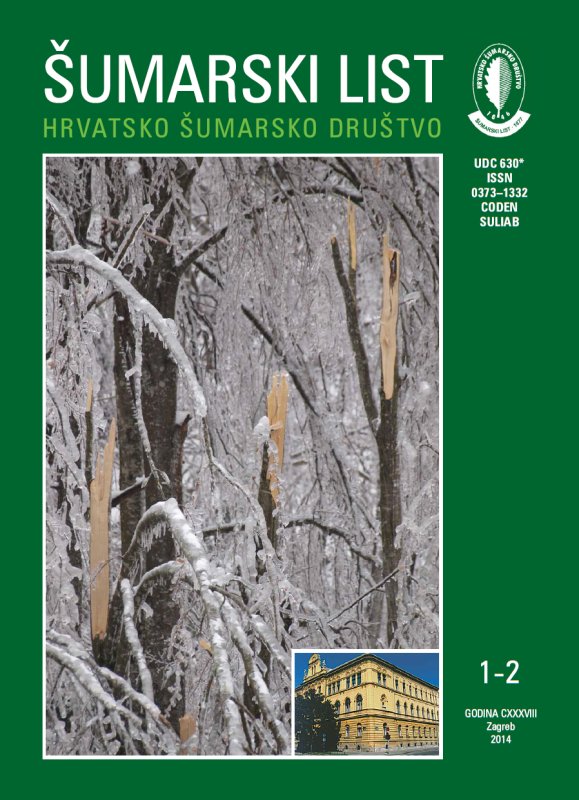
broj: 1-2/2014
pdf (5,91 MB) |
|
||||||||||||||
| RIJEČ UREDNIŠTVA | ||
| Uredništvo | ||
| FREEZING RAIN IN GORSKI KOTAR pdf HR EN | 5 | |
| IZVORNI ZNANSTVENI ČLANCI | ||
| Igor Poljak, Marilena Idžojtić, Irena Šapić, Joso Vukelić, Marko Zebec | UDK 630*164 (001) | |
| POPULATION VARIABILITY OF GREY (Alnus incana /L./ Moench) AND BLACK ALDER (A. glutinosa /L./ Gaertn.) IN THE MURA AND DRAVA REGION ACCORDING TO THE LEAF MORPHOLOGY pdf HR EN | 7 | |
| Jaroslav Holuša, Emanuel Kula, Filip Wewiora, Karolina Lukášová | UDK 630*453 (001) | |
| FLIGHT ACTIVITY, WITHIN THE TRAP TREE ABUNDANCE AND OVERWINTERING OF THE LARCH BARK BEETLE (Ips cembrae) IN CZHECH REPUBLIC pdf HR EN | 19 | |
| Bojan GAVRILOVIĆ, Branka GAVRILOVIĆ, Srećko ĆURČIĆ, Dejan STOJANOVIĆ, Dragiša SAVIĆ | UDK 630*453 (001) | |
| LEAF BEETLES (COLEOPTERA: CHRYSOMELIDAE) OF MT. FRUŠKA GORA (VOJVODINA PROVINCE, NORTHERN SERBIA), WITH AN OVERVIEW OF HOST PLANTS pdf HR EN | 29 | |
| Ante P. B. KRPAN, Željko TOMAŠIĆ, Igor STANKIĆ | UDK 630* 537 + 562 (001) | |
| STUDY OF BIOPRODUCTIVE AND ENERGY POTENTIALS OF INDIGOBUSH (Amorpha fruticosa L.) pdf HR EN | 43 | |
| STRUČNI ČLANCI | ||
| Marko Zebec, Marilena Idžojtić, Igor Poljak, Maja Zebec | UDK 630*272 | |
| DENDROFLORA AND HARMONY OF THE ARCHITECTURAL AND HORTICULTURAL ELEMENTS OF THE PARK SURROUNDING THE FACULTY OF FORESTRY AND THE FACULTY OF AGRICULTURE AT THE UNIVERSITY OF ZAGREB pdf HR EN | 55 | |
| Summary The park surrounding the Faculty of Forestry and the Faculty of Agriculture, University of Zagreb, is located within the Maksimir Public Garden, east of the Bliznec Brook. Established in the 1950s, and covering an area of 5.7 ha, the park abounds in woody plant species, varieties and cultivars, with a total of 112 plant taxa. Out of these, 37 are Gymnosperms, while Angiosperms are represented by 75 taxa (Tables 1 and 2). The pavilion complexes serving as a teaching venue for the Faculty of Forestry and the Faculty of Agriculture of the University of Zagreb, and for research in the fields of forestry and agriculture, as well as a number of 19th century buildings, all situated inside the park, represent a rich cross-section of architectural development from the first third of the 19th century to the features of contemporary architecture at the start of the 21st century (Figures 1 to 8). They paint in broad strokes the development of architectural styles and thoughts, showing, incorporated in their detail, some interesting and specific features that are related to the history of Zagreb architecture, as well as the particular qualities associated with the expression of individual authors. At the time of the park development, the tendency was to design a space primarily intended for the education of forestry and agriculture students, neglecting the aesthetic and ornamental function of the plants. There was no prevailing concept in parallel with the planting of the plant material; the emphasis was rather on the greatest possible representation of different taxa within the park. As a consequence, the park does not open towards the visitor with a comprehensive spectrum of morphological characteristics of the planted taxa. In the beginning, the main element of the space is always an architectural element, whereas the plants were planted only in the conclusive phase, after the construction. As at the time of development of the park surrounding the Faculty of Forestry and the Faculty of Agriculture insufficient consideration was given to the harmony of horticultural and architectural elements, this paper provides concrete solutions for the selection or modification of horticultural elements, with a view to establish the previously non-existent balance of the natural and artificial forms without aggressive interventions in the space, based on a complex analysis of relations between the spatial features of buildings and the representative morphological features of individual plant taxa. Key words: architectural elements; horticultural elements; comparative analysis; inventarisation of woody plants; the park surrounding the Faculty of Forestry and the Faculty of Agriculture | ||


